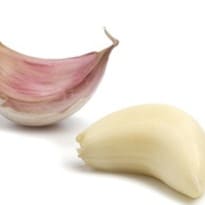Lidl is selling a new variety of garlic, with easy-to-peel cloves. Is it worth buying - and if not, which is the best variety for you?
"Lazy garlic" - what will they think of next? Lidl is selling garlic heads, each about half the size of normal, but consisting of just one clove. What's the point of that? "Very easy to peel and can therefore be prepared much more quickly," says a spokesperson for the chain. The garlic is "uniquely fragrant".
Sampling some, I thought it not very different from ordinary garlic. But it has more ka-boom than the feeble elephant garlic you see sometimes on the veg counter. It's big and easily peeled but it is in fact a type of leek posing, rather pathetically, as a garlic.
Lidl's solo or pearl garlic is the real thing: a version of allium sativum, the plant that worried our grandparents on trips to French restaurants and keeps vampires at bay. This variety grows as a single clove because of the planting practices and the warm climate in Yunnan, a mountainous region of southern China.
Do we need it? Probably not. Garlic peeling can be a quick and satisfying task. (Most of us just put the clove under the blade of a chopping knife and press down with the heel of the hand till the skin cracks and loosens. But others have more magical methods.) More disturbing, my local greengrocer won't stock this or any Chinese garlic as they believe many farmers fertilise their soil with untreated human faeces.
Lidl says its garlic meets the store's global standards. And, to be fair, the Chinese certainly know what they are doing when it comes to garlic. They domesticated the plant 7,000 years ago, and are responsible now for 80% of the world's production. People in Northern Asian countries eat more garlic than anyone else, not least because of garlic's reputation there as a medical remedy for everything from lung cancer to bird flu.
In recent years Chinese garlic imports "have flooded the European and American market" because - surprise, surprise - production is so much cheaper. It's produced year-round, too. That has confused garlic lovers, who used to be able to guess the strength of the garlic by the time of the year. The longer a garlic has been stored, the stronger it is - so in late winter it was at its most invigorating. In May you get the fun of cooking with the mild "wet" or new season garlic.
It's worth having a look around at different types of garlic - you can get very different effects with different types, in different seasons. Organic garlic is a reliable way of avoiding the bleaching that may be done to make the the bulbs look perfectly white. There are at least 70 varieties grown and most of them were developed for different environments, rather than to satisfy taste demands. Sadly there's virtually no commercial garlic farming in Britain now - though there's an interesting farm specialising in heritage varieties on the Isle of Wight.
Porcelain garlic
The classic, pearly white garlic, with a stiff neck and figure-hugging skin. It holds just four or five uniform cloves. The neck is the remains of the bulb's shoots, a snaky tangle known as the "scape" which can be used in cooking. White garlic is beautiful to look at, simple and strong in taste.
Rocambole garlic
Purple-streaked, loose skinned, a big-flavoured garlic that doesn't keep long. Hot and full of flavour, they are a chef's favourite. High in sulfenic acid, which gives garlic its chilli-like burning taste, but quickly dissipates. (If you want to conserve this heat, treat the garlic gently - don't crush the clove, and cook it less.)
Spanish or red garlic
Gorgeous purple colour, almost fig-like and often very large. Some varieties can be mild, others, such as the chesnok, are high in sugars and have been declared the best for roasting. Here's a favourite roast garlic and pea soup from Nigel Slater's book Real Food.
Artichoke or Italian garlic
A group of bulgy, many-cloved types. Taste varies wildly with age and type, and green shoots may appear early in some of the cloves. These can be easily removed if you slice the clove in half from the top.
Black and smoked garlic
More fashionable in recent years, both are modern inventions. Black garlic is fermented at high temperature to give a sweet, yeasty taste that some cooks use to boost flavour. I have had no joy from it. Smoked garlic is generally made, like smoked fish, with oak chips - the process doesn't add any extra life to the bulb. But, roasted, its good spread on toast as a bruschetta.
Wild garlic
The lush sword-like leaves that grow in damp patches in British woodlands from early spring are the product of a different species of allium. But they're a lovely taste of the new season. You can use them, or the little white flower heads that arrive later in salad, stuff a roast chicken with them, or crush them into a pesto sauce with some basil and olive oil.
Photo: Garlic cloves ... but do you know your breeds? Photograph: Alamy










